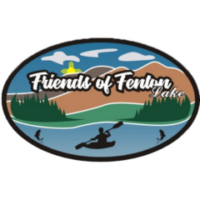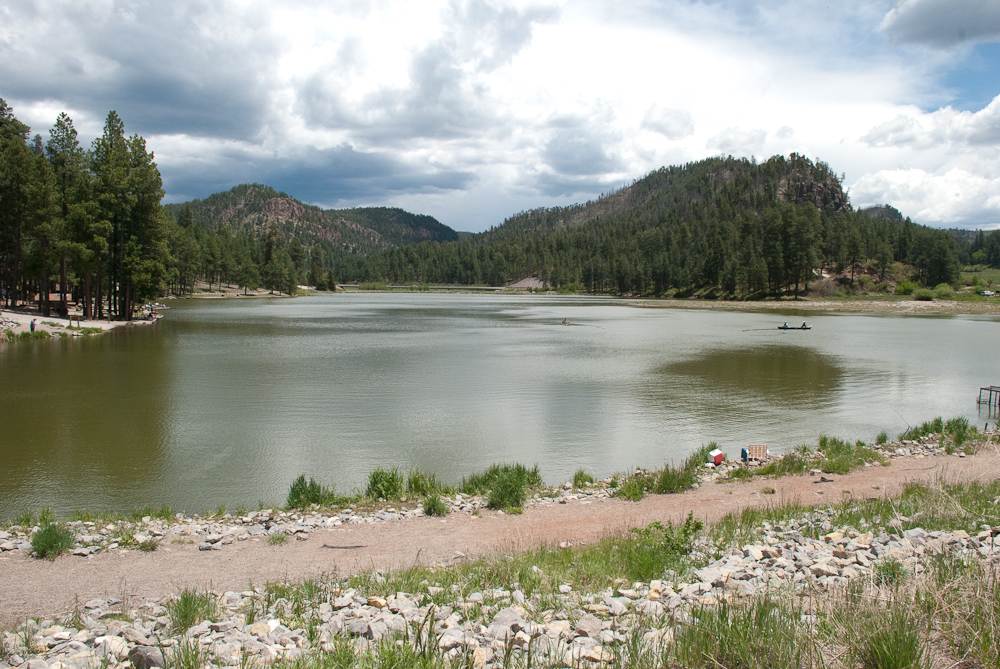Nestled in the Jemez Mountains of New Mexico, Fenton Lake is surrounded by lush forests and mountainous terrain. It is a haven for fishing, camping, hiking, canoeing and outdoor enthusiasts.
The Beauty and Biodiversity
The lake is the result of damming the Rio Cebolla, a spring creek that starts in the Santa Fe National Forest just west of the Valles Caldera National Preserve. The lake elevation is 7900 feet with a surface area of 37 acres. The area around the lake is forested with Poderosa Pines and Douglas Firs, and its cliff sided canyon an orange/brown volcanic tuff. The lake is home to ospreys, migratory birds, and array small animals such as squirrels, chipmunks, and rabbits. Bears, mountain lions, and coyotes occasionally frequent the Parks’ backcountry, but are rarely seen by visitors. The lake supports populations of stocked rainbow trout and Rio Grande Cutthroat trout, and has a naturally reproducing population of wild brown trout, all o0d which make it a popular Jemez fishing destination. The Park includes two sections of the Rio Cebolla that are stocked with rainbow trout and have resident wild brown trout
Recreational Activities
Fenton Lake is a year-round destination offering a plethora of activities. During the warmer months, visitors can enjoy fishing, kayaking, and canoeing on the calm waters. The surrounding area provides excellent hiking trails that offer stunning views of the lake and the Jemez Mountains. One of the most popular trails is the East Fork Trail, which follows the East Fork of the Jemez River and provides access to scenic vistas and lush meadows. Camping is another favorite activity at Fenton Lake. The state park offers well-maintained campgrounds equipped with facilities, making it an ideal spot for families and solo campers alike. As the seasons change, the park transforms into a winter wonderland, attracting visitors for ice fishing, cross-country skiing, and snowshoeing.
Ecological Significance and Conservation Efforts
Fenton Lake plays a crucial role in the local ecosystem. It serves as a natural reservoir, supporting various species of wildlife and maintaining the hydrological balance of the region. The lake and its surroundings are part of the Santa Fe National Forest, which is managed by the U.S. Forest Service. Conservation efforts are in place to protect the delicate ecosystems within this area. The Forest Service works closely with local organizations to monitor the health of the lake and its environs, ensuring that recreational activities do not negatively impact the natural habitat. These efforts include water quality monitoring, habitat restoration projects, and public education campaigns to promote responsible outdoor recreation.
Cultural and Historical Context
The Jemez Mountains, where Fenton Lake is located, hold significant cultural and historical importance. The area has been inhabited for thousands of years by Native American tribes, including the Jemez Pueblo. The lake and the surrounding region are steeped in history, with numerous archaeological sites providing insight into the lives of the indigenous people who once thrived here. Fenton Lake State Park also offers interpretive programs that educate visitors about the cultural heritage of the area. These programs often include guided tours, talks, and demonstrations by local experts, providing a deeper understanding of the region’s history and its connection to the land.
Planning Your Visit Fenton Lake State Park is easily accessible from Albuquerque and Santa Fe, making it a convenient getaway for both locals and tourists. The park is open year-round, with varying hours and amenities depending on the season. It’s advisable to check the park’s official website for the latest information on conditions, regulations, and available facilities. Whether you’re seeking a peaceful retreat in nature, an adventurous day of fishing and hiking, or a deeper connection to the cultural heritage of New Mexico, Fenton Lake in the Jemez Mountains offers something for everyone. Its stunning landscapes, rich biodiversity, and historical significance make it a must-visit destination for those looking to explore the natural beauty of the Land of Enchantment.

